
Nuts have long been considered a true reflection of wealth. Their symbolism relates to fertility, happiness, prosperity and also mystery. Nuts, therefore, have all the attributes that we associate with a happy, dignified and material-rich life. Nuts are also associated with health, well-being, and wisdom. This, of course, is reflected in the micronutrients they contain and their impact on our body.
Who can eat nuts?
Nuts are quite caloric. The caloric content depends on their type, but on average they are around 500-600kcal per 3.5 oz / 100 grams. Therefore, 1 oz /30g of nuts a day is enough. This is enough to provide yourself with the necessary dose of health. At the same time, it is incorrect to believe that nuts shouldn’t be eaten by people on a diet. On the contrary – it is a great snack, providing at the same time such essential unsaturated fats, about which you can read about health benefits here. In addition, nuts have a low glycemic index, so they are also recommended for people on a low-glycemic and protein diet. Nuts are also recommended for diabetics and do not contain gluten themselves, so they are safe for people with gluten intolerance. The only thing you need to remember is that nuts are extraordinarily strong allergens – which applies to people with food allergies, intolerant to nuts.
*Recommended daily serving of nuts
The Australian Dietary Guidelines recommends one serving of nuts per day for adults. One serving is equivalent to approximately 1 oz/ 30 grams or one third of a cup (or one handful). Since all nuts are remarkably similar in term of nutrient content, a wide variety of nuts can be included as part of a healthy diet. This will give you about:
- 30 almonds
- 10 Brazil nuts
- 15 cashews
- 20 hazelnuts
- 15 macadamias
- 15 pecans
- 2 tablespoons pine nuts
- 30 pistachios
- 10 whole walnuts or 20 walnut halves
- a small handful of peanuts or mixed nuts.
Types of nuts and their properties
All nuts have a positive effect on health. They are said to be effective mood enhancers, they work very well on the brain and concentration, as well as support beauty. What is more – they differ not only in taste, but also in properties!
I. Walnuts

They consist of 15% of high-quality protein, which is why, like almonds and cashews, they are an important component of a vegetarian diet. They are distinguished by a record content of polyunsaturated fatty acids – already 3 walnuts cover the daily requirement for omega-3 fatty acids. They are also a rich source of vitamin B6. Due to the high content of folic acid, walnuts are recommended for pregnant women. They are a valuable source of antioxidants, magnesium, and fiber. Due to their phosphorus content, they are also called brain food, so it is good to include them in your diet by students and students.
Caloric content of walnuts: 666 kcal / 3.5 oz /100 g.
II. Hazelnuts
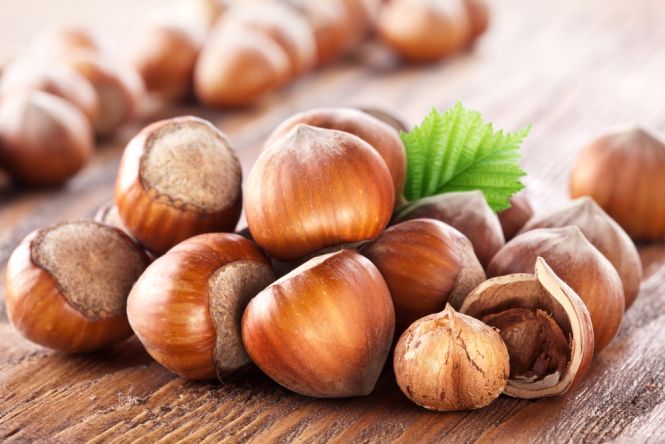
Hazelnuts are one of the most delicious snacks. They are often referred to in the context of potency improvement, because they contain a large amount of vitamin E. A microelement of vitality and youth. Hazelnuts also contain a lot of unsaturated fatty acids, most of them monounsaturated. It has been proven that monounsaturated fatty acids lower the level of “bad” cholesterol and increase the HDL fraction – the consumption of hazelnuts and the oil pressed from them is therefore recommended in the prevention of atherosclerosis. These nuts are also rich in vitamin E (15 mg / 3.5 oz – 100% of the daily requirement) and folic acid necessary for the proper development of the fetus. What is more, they are a source of potassium, and thus support the regulation of blood pressure.
Caloric content of hazelnuts: 640 kcal / 3.5 oz /100 g.
III. Peanuts

Peanuts, otherwise known as ground nuts (because they mature underground). Botanically, they belong to the same plant group as peas, beans, and soybeans. That is why peanuts have the most protein of all nuts – 25 g / 3.5 oz . But they resemble nuts in terms of taste and amount of fat. They are distinguished by a record amount of vitamin B3 (niacin), which soothes, calms, calms down, and makes it easier to fall asleep. People suffering from high blood pressure and diabetes should reach for them . They are also rich in vitamin E and folic acid but are not recommended for pregnant women as they often cause allergic reactions. They are an extremely popular addition to homemade bars, cakes, and dried fruit mixes. It is from them that peanut butter is made! It is better to avoid roasted and salted peanuts and buy natural ones in the shell. The oil pressed from them is great for frying, and peanut butter is a delicacy for children
Caloric content of peanuts: 560 kcal / 3.5 oz /100 g.
IV. Cashews
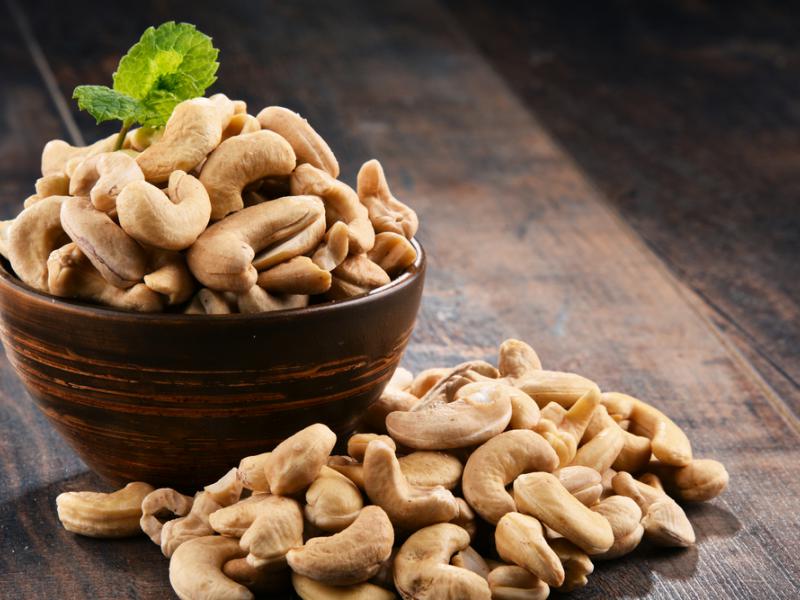
Cashews are nuts whose name refers to their very characteristic kidney-like shape. They also have an easily recognizable taste – they are a bit sweet and very delicate, which makes them a great snack and
Their soft, slightly sweet, and slightly almond flesh is considered the most subtle of all nuts. Cashews contain a lot of protein (18%), magnesium, phosphorus, zinc, and iron (in terms of the content of these elements, they are ahead of all nuts). and are also a good source of vitamin K to help prevent blood clots. People who live under constant stress should pay special attention to them, because they have a soothing effect, improve well-being and concentration. Their most important activity is protection against type 2 diabetes, which has been scientifically proven. The tastiest nut in the world is usually eaten without any processing, as a snack or addition to cakes, salads, to any type of breakfast cereal or porridge or simply desserts.
Caloric content of cashew : 553 kcal / 3.5 oz /100 g.
V. Almonds

Almonds are definitely favorites among all nuts. Their great value is their taste – mild, slightly sweet, perfect for desserts. Almonds consist of over 20% protein (only peanuts have more protein among nuts). They are a rich source of magnesium that protects against stress (270 mg / 3.5 oz – 80% of the daily requirement for this element) and phosphorus. It is also worth reaching for them due to the highest content of vitamin B2 and vitamin E among nuts – necessary for the proper functioning of the skin and delaying the aging process. The fat in almonds contains many monounsaturated fatty acids that have properties that lower blood cholesterol. Almonds are also distinguished by the lowest content of saturated fatty acids and the highest – fiber (12.5%), so they can be reached by people on a slimming diet. They are especially recommended for women in the first months of pregnancy because they effectively reduce nausea. Almonds can also relieve heartburn. Almonds are a valuable source of not only healthy unsaturated fats and protein, but they are also high in fiber.
Caloric content of almonds: 579 kcal / 3.5 oz /100 g.
VI. Macadamia
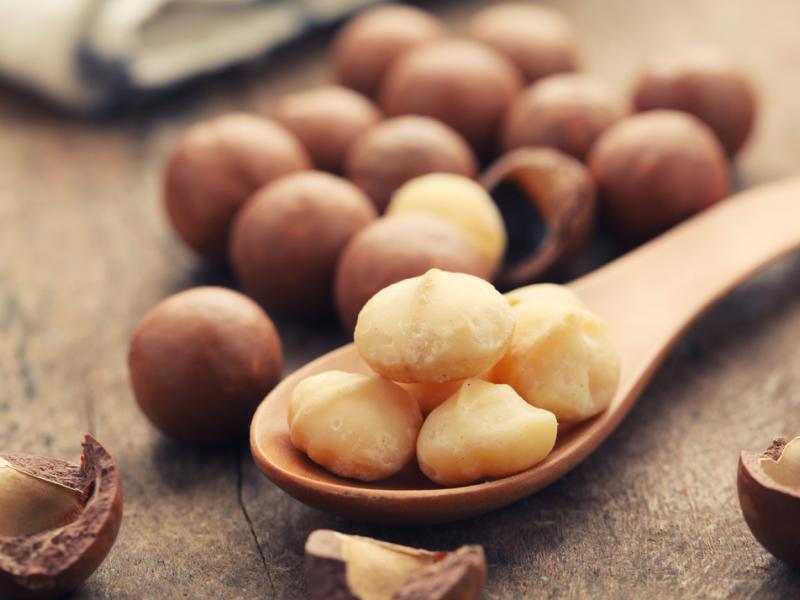
They come from Australia, where they grow wild, and are currently grown in Hawaii and South Africa. These nuts have a characteristic, round shape and are best purchased in the form of peeled seeds. Their shell is extremely hard and difficult to remove. They owe their extraordinary power to healthy fats that reduce the risk of atherosclerosis. They are extremely high in monounsaturated fatty acids – studies have shown that macadamia nuts reduce the risk of thrombosis and coronary heart disease. They have a delicate, slightly buttery flavor. They make a tasty snack. They are used for baking and go well with garlic and anchovy sauces, as well for pastes or salsas. It should also be noted that they have gained popularity not only in the food industry, but also in the cosmetics industry. Macadamia nut oil perfectly moisturizes and is widely recommended in skin and hair care!
Caloric content of macadamias: 718 kcal / 3.5 oz /100 g.
VII. Pistachios
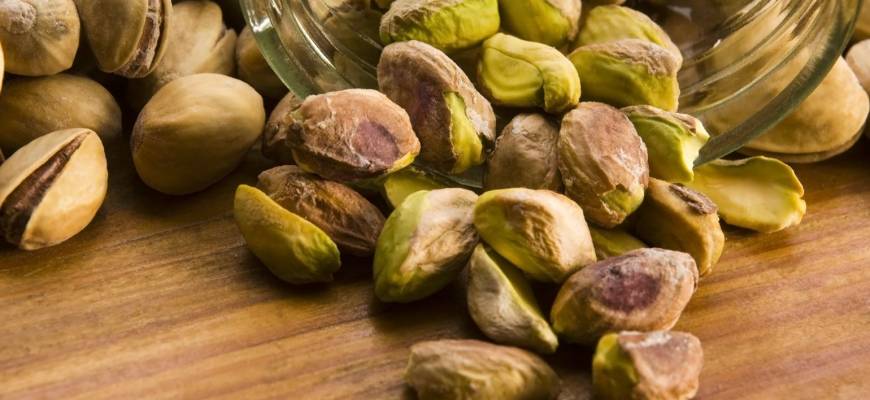
Pistachio are in fact seeds , of the Pistachio tree. They are hidden in grayish looking, hard shell. They contain a lot of protein (20%), are extremely rich in beta-carotene (250 mcg), potassium (1000 mg in 3.5 oz – 1/3 of the daily requirement), vitamin B6 (75 g of pistachios are enough to meet the daily requirement for this vitamin) and vitamin B1. They remarkable properties are resulting from the high content of B vitamins, especially vitamin B6, which has a positive effect on the nervous system, calming and improving the mood. However, this is not their only activity. Pistachios have a beneficial effect on the entire human body, due to their ingredients: unsaturated acids, fiber, antioxidants, potassium, phosphorus, and carotenoids, which cannot be found in any other type of nuts. That is why pistachios are recommended for many different ailments. They reduce the risk of lung and prostate cancer, strengthen eyesight, lower blood pressure and sugar levels, reduce the level of bad cholesterol and are recommended for anemics. Unroasted pistachios are healthier and harder to find in stores – roasting reduces the antioxidant content in pistachios by up to half! Remember, however, that we only buy unsalted ones!
Caloric content of pistachios: 589 kcal / 3.5 oz /100 g.
VIII. Pecans
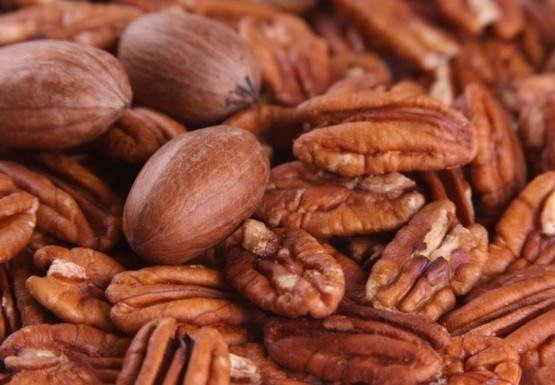
They are also called American peanuts. Their flesh is similar in shape to a walnut, but they are sweeter, more delicate and more buttery in taste. They contain an exceptionally high amount of fat (72%) – which makes them very caloric – and little protein (9%). Just like hazelnuts, pecans have a lot of monounsaturated fatty acids, but also a lot of polyunsaturated fatty acids. They are a rich source of zinc – 3.5 oz of pecans meet 60% of the daily requirement for this mineral. They are used similarly to walnuts , by being ground for cakes, creams, which gives them a delicate spicy flavor, whole for decoration or as a snack.
Caloric content of pecans: 692 kcal / 3.5 oz /100 g.
IX. Pine
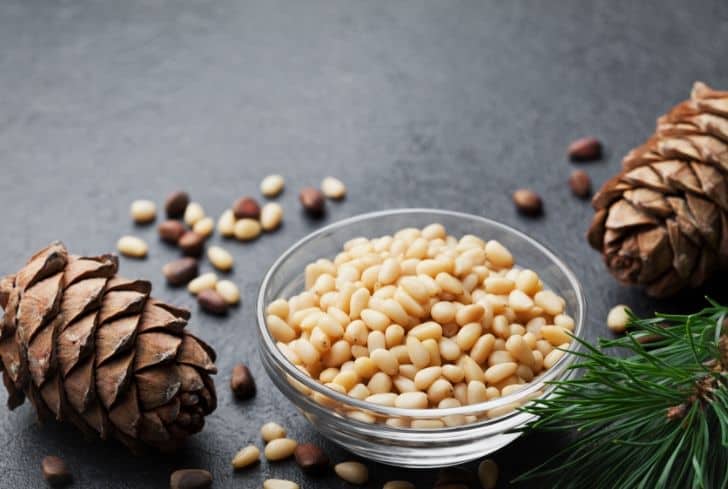
So pignoli nuts or pine nuts. They are acquired from the cones of the Mediterranean pine species. They are tiny, so there is no need of chopping them; they are often sprinkled on top of pasta or salads. They are part of the famous pesto sauce (peanuts crushed with garlic, basil, salt, olive oil and Parmesan cheese). They have a delicate flavor in themselves. They contain little protein, thanks to fatty acids they lower cholesterol. They are a good source of zinc and magnesium. They are used to soothe inflammation and help with a dry cough. They go stale very quickly, so it is not worth buying them in large quantities, especially since these are the most expensive dried fruit.
Caloric content of pine nuts: 629 kcal /3.5 oz /100 g.
X. Brazil nuts
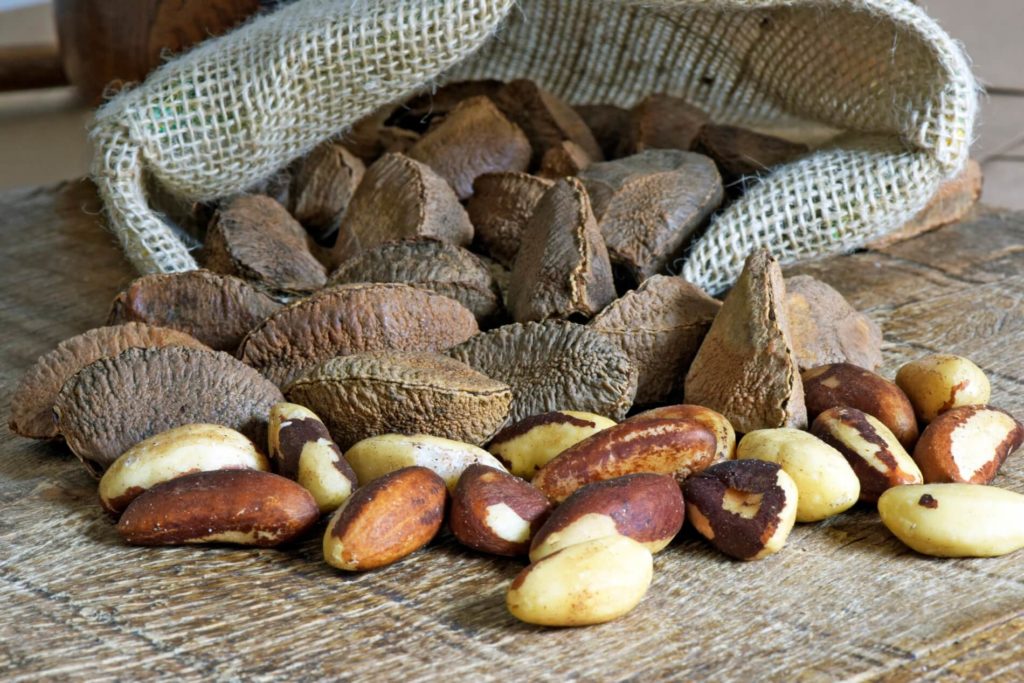
They grow wild on the Amazon. Brazil nuts are one of the richest plant sources of selenium, and, due to its antioxidant properties, plays an important role in preventing cancer. One Brazil nut is enough to meet the daily selenium requirement! Most often they are eaten raw. You can add them to fruit and vegetable salads, sauce, meat. They go well with spicy spices. They are made into sweet butter.
Calorific value of Brazil nuts: 660 kcal /3.5 oz /100 g.
XI. Chestnuts ( edible ones)
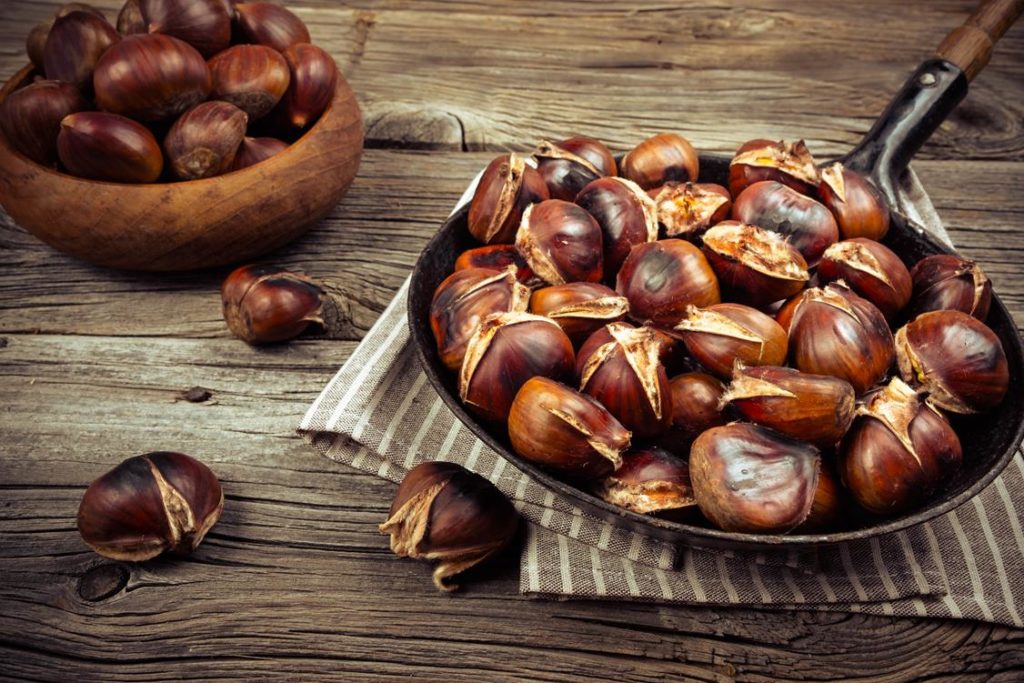
Chestnut belong to the tree nut family; therefore it deserves a place in today post. We all know how the chestnuts look like . Shiny, brown fruits, hidden within hard green skin, equipped with spikes. Chestnuts depart from the norm for culinary nuts, as they have little protein or fat; their calories come primarily from carbohydrates. Chestnuts contain extraordinarily little fat, mostly unsaturated, and no gluten. Chestnuts have double the amount of starch as the potato. They contain about 8% of various sugars, mainly sucrose, glucose, fructose. They are the only “nuts” that contain vitamin C, with about 40 mg per 100 g of raw product, about 65% of the US recommended daily intake. The amount of vitamin C decreases by about 40% after heating.
Calorific value of Chestnuts: 190 kcal /3.5 oz /100 g
Take care of yourself 🙂
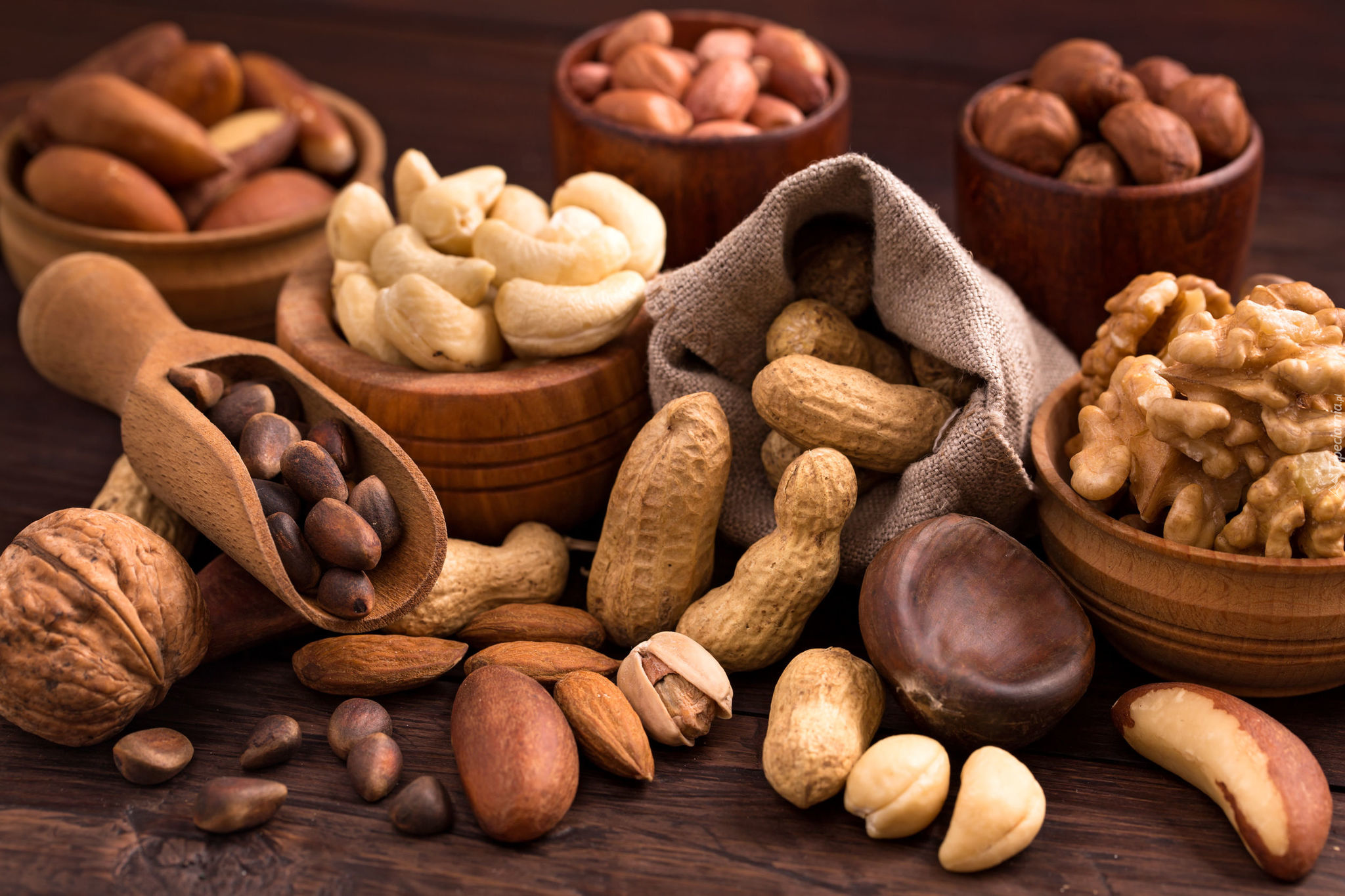



Nice write up, please can we fellow each other’s blog
sure,